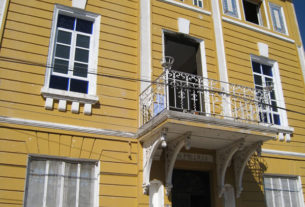Juan Mata Ortíz is a small village of potters, farmers and cowboys in Northern Chihuahua. About 30 years ago, an unschooled artistic genius, Juan Quezada, taught himself how to make earthenware jars in a method used hundreds of years ago by the prehistoric inhabitants. Now, his works are known worldwide and over 300 men, women and children in the village of less than 2000 make decorative wares. Much of the polychrome and blackware is feather light and exquisitely painted.
Many of the potters are also cowboys and farmers. These stories serve to document the art and the people in this unassuming pueblo, which is often called “magical” by the relative handful of tourists who visit. Enjoy this other view of Mexico.
One day, while in Nuevo Casas Grandes, the city near Mata Ortíz, I watched a mechanic testing to see if a tire was balanced. His taller was a typical Mexican car shop–dirty rags wriggling in the wind, sets of greasy tools scattered inside and outside a small dusty metal shed along the road. The closest thing to an electronic implement was the neon Carta Blanca sign at the liquor store next door.
A dented pickup truck was hitched akilter with a jack. A “new” used tire had just been secured to the left rear wheel. Nothing spectacular here — but I was amazed to see the mechanic placing a Coke bottle on each side of the raised tire. Curious, I stopped to watch. Ignoring the ground, which oozed with old oil, the technician kneeled down and studied the tire and the bottles. Carefully, he slid the empty Cokes closer, bracketing the wheel until there was barely a breath of air between the glass and the vulcanized rubber. Nearby, the young man, whom I assumed was the truck’s owner, looked on.
Finally, the mechanic jumped up and spun the tire with a quick snap of his hand. The wheel spun straight and true, not touching the soda bottles.
“Ya!” the mechanic grunted, satisfied. “Now, it is done.”
I had just watched a tire balancing the old fashioned way. No fancy equipment, just logic and the common sense to make do with the materials at hand. Travelers in Mexico see examples of such adaptations everyday – much as one might have seen crossing rural America 40 or 50 years ago.
I come from a mechanically deficient family. When something broke down, we reached for the telephone. For me, turning on an electric light is miraculous. I understand the concept of binary language (more or less) but still can’t figure out how a bunch of zeros and ones can create colors and incredible graphics on a screen.
So I admire Mexicans, and what they can do with so little.
Recently, a nationally known muffler company installed four new shocks on my faithful Isuzu Trooper. Afterwards, by the time I reached Mata Ortíz, the rear end was bouncing like a basketball on Speed. My compadre, a mechanic, peered underneath and announced that one shock had disappeared and the other was dangling by one bolt. (The muffler company’s explanation was, “Gee, sometimes things happen”). To save my frame, the Mexican mechanic chopped up an old tire and fastened the hunks underneath to create a cushion. Worked fine until I could return to El Paso three days later.

The potters of Mata Ortíz are also wonderfully adaptive. Natural materials are the order of the day for the pottery–clay, slips for color and fuel (dried cowchips or cottonwood bark) are all found in the nearby valley and mountains. But, it is their other tools that are particularly intriguing.
After a pot is initially shaped, it must be scraped and thinned and thinned again – for the philosophy is ‘the thinner and smoother the piece, the better’. Scraping usually involves employing a broken hacksaw blade or an old table knife. But to conform the inside of the pot or jar a variety of tools is used: bent spoons, pieces of plastic, hunks of gourd.
The pottery is known for the extremely fine-lined painting. The brushes are hand-made. The bristles — and there are only three or four of them — are entwined to appear as one. The source? The hair of the potters’ children. When my friend Carmen teaches a pottery class in the village, her husband Jesus has to make a dozen or more brushes for the students. Their little son Juanito scampers to hide when he sees dad approaching with the scissors.
Only a child’s hair works, according to the potters. I asked one artist, Nicolas Quezada what he does now, as all his children are grown.
“Oh,” he said, “I just go out onto the street and look around for a kid going by. No problem.”
For the handles, sticks, old syringes, used pens all work fine.
Even the kilns used for firing are clever utilizations of ordinary objects: inverted terra cotta flowerpots for colored ware and big tin tubs for black ceramics.
My excuse for not making pottery is that I am not artistic — I can’t even draw a crooked line. But, I think there is another reason. As technically inefficient as I am, even if I formed a pot, I probably couldn’t figure out what to do next!


